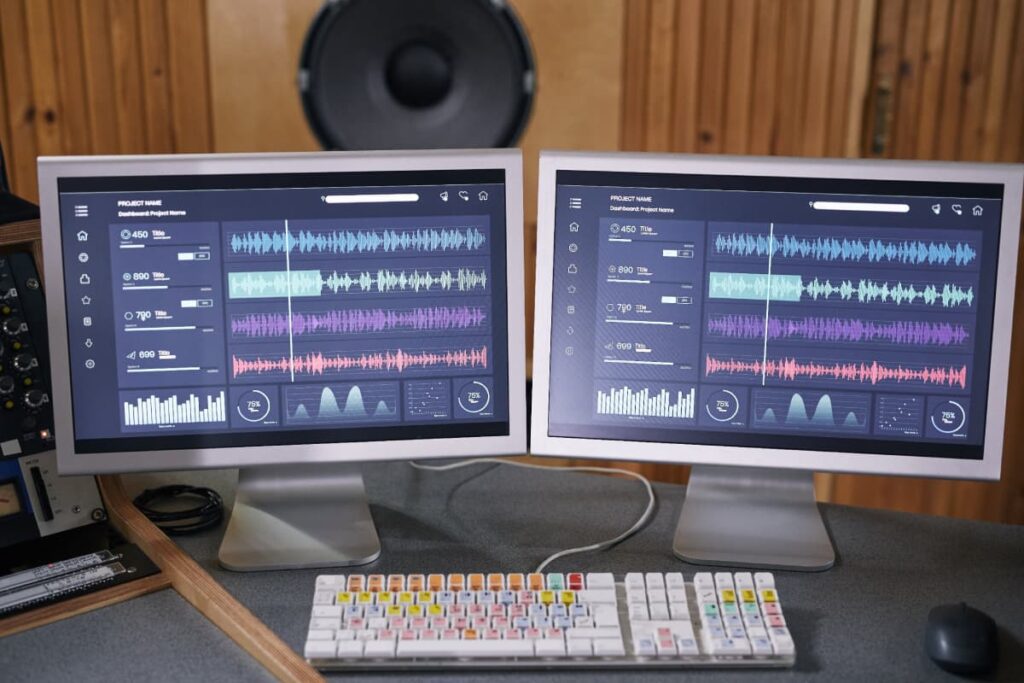If you have ever been to a professional studio and wondered why there was more than one set of audio monitors, then you are not alone. Most people understand why producers studio monitors, but the need for an extra pair isn’t as clear.
Producers use two sets of monitors to enable them to hear a sound from different perspectives. Different sets of monitors will also enable the producer to listen to how the song sounds in different types of speakers. The goal is to achieve a mix that works well with all types of speakers.
That’s the short answer, but include all the uses producers give to having several sets of speakers. In the rest of the article, I’ll explain the importance of studio monitors and how they’re used. This will provide a more comprehensive answer to the question.
Table of Contents
- Why Producers Need Multiple Monitors
- Understanding Studio Monitors and Their Function
- Choosing the Right Studio Monitors
- Final Thoughts on Multiple Speakers

Why Producers Need Multiple Monitors
Every producer wants their finished product to be enjoyed by a wide variety of listeners.
It may happen to producers that everything sounded lovely in the studio, only for it to sound very different in a casual environment.
Why do Producers have Two Sets of Monitors
To avoid this, producers and mixing engineers listen to their mix in as many types of speakers as possible.
Aside from listening on actual studio monitors, producers and mixing engineers will also listen to their work on mobile phones, mono outputs, car radios, and other cheap speakers. The idea is to make the mix sound well across all these different types of speakers.
Understanding Studio Monitors and Their Function
To help us fully grasp this subject, we need to understand studio monitors and how they are used.
What Are Studio Monitors?
Studio monitors are speakers used in a studio to listen to or monitor the progress made on an audio production project. These speakers are designed to be transparent. They reproduce the sounds without adding any form of coloration.
The explanation above may still leave some readers confused. If the speakers don’t add coloration, why do you need more than one? Shouldn’t they all sound the same?
To clarify this issue, we will look at the different types of studio monitors that producers use.
Types of Studio Monitors in the Control Room
The classification of studio monitors is based on a number of parameters. These include:
- Powered or Passive: This describes how the speaker is powered. A powered speaker has a built-in amplifier, while a passive speaker requires external amplification.
- Near Field or Mid-Field: This refers to the distance a speaker should be positioned with respect to the listening area.
- Ported or Non-ported: This is used to distinguish speakers that have holes from those that are completely sealed.
- Subwoofer: This is a speaker that mainly reproduces low frequencies
Remember that the primary purpose of the studio monitor is to help the producer create the exact sounds they want.
The producer needs to hear a transparent reproduction of the sounds to ensure the mix is just right.
Powered or Passive
This is mainly a matter of choice.
Powered or active monitors offer more convenience and can be found in most studios. A passive monitor will require dedicated amplification. This is why it’s not the choice that most studios go for.
However, going for a passive monitor allows you to have more control over the amplification part of the audio chain.
Near-Field or Mid-Field
Near-field monitors are a producer’s best friend.
Every studio has near-field monitors. They are designed to be placed about 3 feet (0.91 m) from the listening position. For small studios, this is the type of monitor they need.
Mid-field monitors offer extended throw, making them ideal support speakers in larger studios. They are usually placed about 8 to 10 feet (2.43-3.04 m) from the listening position.
You will usually find producers switching between the two sets of monitors to ensure that their mix is truly what it was intended to be.
Ported or Non-Ported
This design feature allows a speaker to reach lower frequencies.
With a ported monitor, the air pressure created within the speaker cabinet is pushed out through this port.
The design is such that as the pressure escapes from the port, it resonates at a frequency range that almost matches the monitor’s cut-off frequency.
Frequency Response
This appears to extend the monitors’ frequency response lower than it would have been able to produce without the ports.
Non-ported monitors, however, produce more compact, low-frequency sounds and are not as prone to exaggerating low frequencies as ported models and have a different frequency response.
Subwoofer
This type of speaker is usually deployed in addition to existing near-field or mid-field monitors.
Just as with your home theater, the sub adds low frequencies that the regular reference monitors cannot reproduce. What you will therefore have will be like a 2.1 speaker configuration.
Aside from the types of monitors listed above, it is not unusual for other types of speakers to be found in the recording studio. As I explained above, producers will test their mixes in all the speakers they can get their hands on, including cheap earbuds and laptop speakers.
They’ll want to make their mixes sound as good as possible on a wide range of devices. Whatever sounds good.
Choosing the Right Studio Monitors
At this point, you may ask yourself which of the types of reference monitors would be most appropriate for your home studio space.
The most important thing to consider when choosing a home studio monitor is the size of the home studio.
For most home studios, near-field reference monitors will be more than enough. The quality or efficiency of studio monitors is not determined by how they are or how much output they can push out.
Using multiple monitors with huge output power in a small space is actually counter-productive. Only get mid-field reference monitors if your studio is large enough for it.
Final Thoughts on Multiple Speakers
In this article, we’ve looked at the different types of monitors, their uses, and more.
If you started reading this article without knowing why producers often use multiple sets of monitors (two pairs), you hopefully now know why.
With the information shared here, you should now be able to find the sweet spot and decide which type of studio monitor will best suit different-size studios and choose a good pair (or multiple pairs) for making critical mix decisions.
- Review of the ALABS IRON MINI-WL: A Powerhouse Wireless Microphone - October 4, 2023
- What is a Saturator in Music Production: A Brief Explanation - May 11, 2023
- What Are Rotary DJ Mixers? An Overview - May 11, 2023
SoundStudiomagic.com is a participant in the Amazon Services LLC Associates Program, an affiliate advertising program designed to provide a means for sites to earn advertising fees by advertising and linking to Amazon.com. We also participate in other affiliate programs which compensate us for referring traffic.

